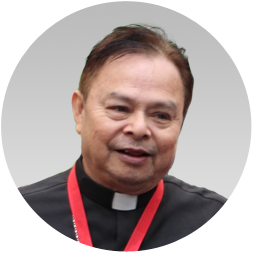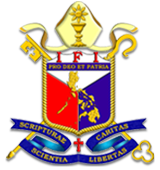IGLESIA FILIPINA INDEPENDIENTE:
Keeping the Flame of Faith Alive
Feature Article: Reflection on the IFI’s 119th Foundation Anniversary

By: The Rev. Dr. Hermogenes Verano (ret)
Former Priest, Birhen Balintawak Mission, Sucat, Paranaque, Metro Manila
Reminiscing from the memory lane, I was initiated into the church when I was a sacristan in the far-flung IFI Parish of St. Matthew in Aloran, Misamis Occidental. Our parish priest then was the late Fr. Cesar de Asis. Serving the parish for five years as a sacristy boy, I was fortified with the Aglipayan stock to enter St. Andrew's Theological Seminary in Quezon City to be initiated into priesthood.
As an altar boy, the best and exciting part in the Holy Eucharist that kept me enthralled and philosophically wondering was when the priest raised up the chalice with the Communion Host, and together the church band simultaneously played the Philippine National Anthem. In a hair-raising moment, it held me abreast and amazingly stupefied putting me into a state of stupor. I was really very proud of what I am, being a nationalist "Filipinista." That was how I was exposed to the church in my formative years. It hasn't changed a bit. The flame of faith in the church is still alive in me.
THE TINY SEED
The seed of Filipinism in this Church can be best described analogically in the book of St. Matthew chapter 13 in which our Lord Jesus Christ pedagogically taught the "Parable of the Seed." The tiny seed sprouted and became deeply rooted but not with so many obstacles. It fell on the wayside and the wicked one caught it. The persecution and tribulation offended it, that was why it did not root in the stony place. Because of the deceitfulness of riches, it got choked and became unfruitful. Ironically, the rough ground of anti-Filipino treatments of both the Spanish government and imperial Roman Catholic Church on the lowly Filipino priests catalyzed and fertilized the seed to grow and to become robust; bearing fruit from a hundredfold to 1.5 million adherents two years after.
THE KEEPER OF THE FLAME
Two outstanding patriots and nationalists conspired to keep the flame burning. One, Isabelo de los Reyes Sr., the firebrand, organizer and prolific writer, ignited the fire, and the other, Monsignor Gregorio Aglipay, the former Roman Catholic priest, carried the torch and with fighting spirit conflagrated the nation with the idea of creating a Filipino Nationalist Catholic Church. With the instigation of the sublime paralytic Apolinario Mabini, it provided more combustion when he said darely: "Let the Filipino clergy show their zeal and love for the church. Let them show their capacity to govern not only to the parishes but also to the diocese. Let them show that the regular orders are not needed in the Philippines to maintain alive the Catholic religion and the Pope who cannot separate from justice as the Vicar of Christ who is God has to recognize the rights and merits of the Filipino priests. This is the most opportune occasion which Divine Providence offers them to obtain the reparation of their grievances those who aspire to be something coadjutors and pages must not let this occasion pass."
1902: THE JOURNEY COMMENCED
Some would say that the secession from the Roman Catholic Church had already started in some places in the Philippines. There were already pockets of rebellion not only in the government but also in religion in Cavite, particularly in Maragondon as initiated by the revolutionary brothers, Generals Emiliano and Mariano Riego de Dios. The independent nationalist church was already in place before 1902 in this particular town where the Bonifacio brothers Andres and Procopio were court-martialed. It was only on August 2, 1902 when the declaration of the founding of the Filipino Catholic Church was made official. A month after the proclamation, Filipino bishops were consecrated to the new Church. Monsignor Aglipay, also the vicar general of the revolutionary government under General Emilio Aguinaldo, was consecrated Supreme Bishop or Obispo Maximo by the bishops of Isabela, Cagayan, Pangasinan, Abra, Nueva Ecija, Cavite and Manila.
The Church was on its way to proselytize in its homeland (Agoncillo, 1990). Adherents from the archipelago swelled from Luzon, Visayas to Mindanao. Dioceses were created. As of now, the clergy consists of approximately thousands of priests in 46 dioceses both here and abroad.
THE FLAME BURNING ALIVE
For the flame intermittently burning, its characteristics behind the tradition must be sustained and be enlightened. There are symbolic properties of its origin. IFI is known for its nationalistic identity. It can be shown in the singing of the National Anthem after the Mass. This is its mooring and it should be kept anchored. Another characteristic is that the Church is unique because allied workers like laborers, farmers, factory workers and employees were the imprimaturs of the declaration of religious independence. They are the very people whom the Church should empower, serve, and defend from injustices and human rights violations. In relation to this, the Ramento Project should be sustained by infusing more funds to maintain it. Seminaries should be beefed-up to be more competitive academically, theologically, and administratively as well.
WHAT THE FUTURE HOLDS
Jesus Christ through the Santo Niño holds our future as He bears the world. It is only by being faithful to His Word that all of us can withstand the onslaught of wickedness and drudgery in this world. Our leaders should be exemplary figures of goodness, morality, and spirituality. We should keep the pace and confront whatever challenges are in store for us as we walk another milestone in our search for truth and spiritual tranquility. Keep the faith alive whatever happens because God is our Light.


